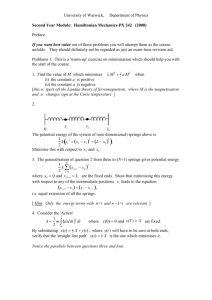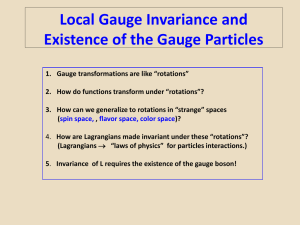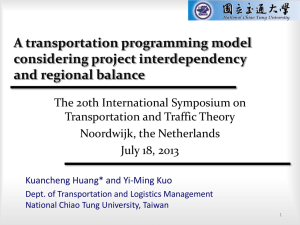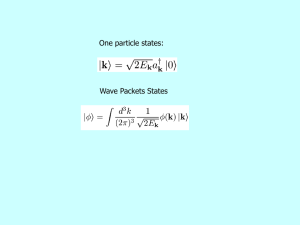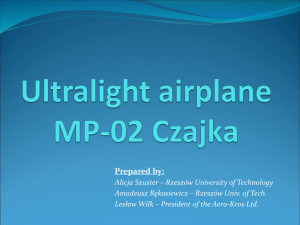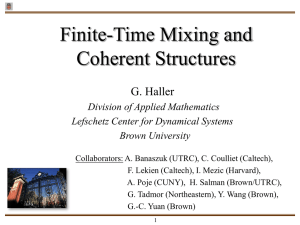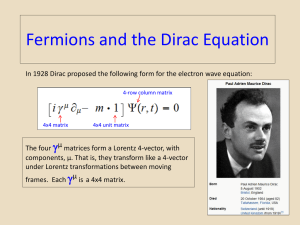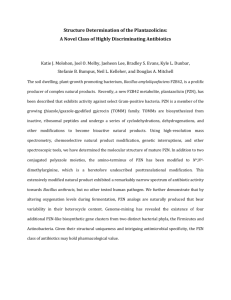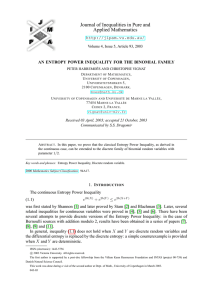YongLong Wang
advertisement
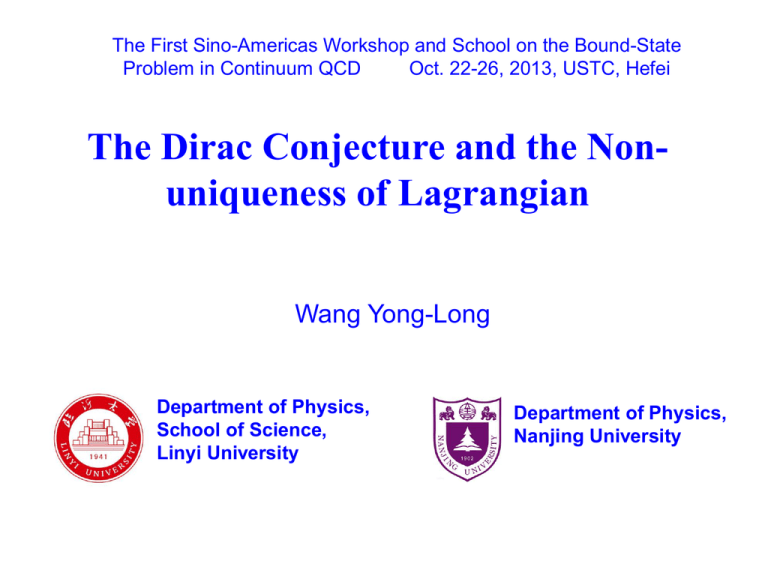
The First Sino-Americas Workshop and School on the Bound-State
Problem in Continuum QCD
Oct. 22-26, 2013, USTC, Hefei
The Dirac Conjecture and the Nonuniqueness of Lagrangian
Wang Yong-Long
Department of Physics,
School of Science,
Linyi University
Department of Physics,
Nanjing University
Outline
Introductions
Non-uniqueness of Lagrangian
Cawley’s Example
“Counterexample”
Conclusions
. arXiv:1306.3580
Introductions
①
Dynamical Systems
Newton
Formalism
Regular systems
Classical and Quantum Constrained
Systems and Their Symmetries. Zi-Ping Li,
Press of Beijing University of Technology,
1993 (in Chinese)
Lagrange
Formalism
Hamilton
Formalism
Singular
Lagrangian
Systems
Constrained
Hamiltonian
Systems
Symmetries
Quantization
Of Gauge
Systems
Canonical Systems
Gauge
Theories
Constrained Hamiltonian Systems and Their
Symmetries. Zi-Ping Li. Press of Beijing
University of Technology, 1999 (in Chinese)
Symmetries in Constrained Canonical
Systems, Li Zi-Ping, Science Press, 2002
Quantum Symmetries in Constrained
Systems. Zi-Ping Li, Ai-Min Li. Press of
Beijing University of Technology, 2011 (in
Chinese)
Symmetries in Constrained Hamiltonian
Systems and Applications. Yong-Long
Wang, De-Yu Zhao, Shandong People’s
Publishing House, 2012 (in Chinese)
The Dirac Conjecture
Quantization of Gauge
Systems, edited by M.
Henneaux, C. Teitelboim,
Princeton University, 1991
Gauge Fields Introduction
to Quantum Theory, edited
by L. D. Faddeev and A. A.
Slavnov, The Benjamin,
1980.
Introductions
Quantization of Gauge Systems
Canonical
Quantization
Dirac’s
Formalism
Path Integral
Quantization
BRST BatalinFradkinVilkovsky
FaddeevJackiw’s
Formalism
②
FaddeevPopov
BRST BatalinFradkinVilkovsky
FaddeevSenjanovic
The Dirac Conjecture
Introductions
③
Lagrange Formalism
Hamilton Formalism
pi
L(q, q ) (q q1 ,, qN )
N RM
L
(i 1,, N )
qi
H C (q, p) pq L(q, q )
2L
The rank of
is R.
qi q j
m (q, p) 0 (m 1,, M )
HT H C mm
" " denotes " weak equality" , f (q, p ) 0
The primary constraints
f ( q, p ) 0
[
,
H
]
0
" " denotes " strong mequality"
f
m , f T( q, p ) 0 f
0
q p
The higher-stage constraints
k (q, p) 0
Introductions
first class constraints m :
[m , m ] 0 (m 1, , M )
m
second class constraints m :
(m 1, , M )
④
(M M M )
m ( q , p ) 0
H T H C U m~m~ mm
H mm
H C pq L(q, q )
According to the consistency of the m , we can obtain
the
Lagrange multipliers with respect to primary second-class
constraints
m [m , HT ] [m , H C ] U n [m , n ] m [m , m ] 0
1
U n Cmn
[m , H ]
Cmn [m , n ]
[m , m ] 0
Introductions
⑤
In terms of the total Hamiltonian, for a general dynamical
variable g depending only on the q’s and the p’s, with initial
value g0, its value at time t is
g ( t ) g 0 t{[ g , H ] m [ g , m ]}
g g ( t ) g 0 t{[ g , H ] m [ g , m ]}
t[ g , H ] t m [ g , m ]
small
arbitrary
m is generator of gauge transform ations
Introductions
⑥
The Poisson brackets of [m , n ] are generator of gauge
transforma tions.
(1) Apply first a contact tr ansformati on with generating
functions m m , and apply a second contact tr ansformati on
with generating functions nn , we get
g g0 n [ g , n ] m [ g n [ g , n ], m ]
(2) We apply the two contact transformations in succession
in reverse order, we obtain finally
g g0 m [ g , m ] n [ g m [ g , m ], n ]
Introductions
⑦
[[ g , m ], n ]
[[ g , n ], m ]
[[ A, B], C ] [[ B, C ], A] [C , A], B] 0
g g g m n [ g ,[m , n ]]
It is arbitrary
[m , n ] is generator of gauge transformations.
P. C. Dirac, Can. J. Math. 2, 147(1950); Lectures on Quantum Mechanics
Introductions
⑧
The secondary constraints can be deduced by the
consistency of the primary constraints as
m m [m , HT ] [m , H ] m [m , m ] 0
1
m1 1,
, M1
(1)The original Lagrangian equations of
motion are inconsistent.
(2)One kind of equations reduces as 0=0.
(3)To determine the arbitrary function of
the Lagrangian multiplier. (for secondclass constraints)
(4)Turn up new constraints.
m
1
[m , H ]
Introductions
m [m , m ]
0
m~1 second- class
m
m1 first - class
m
1
?
generators
m
1
generators
left by Dirac
Dirac conjecture: All first-class constraints are
generators of gauge transformations, not only
primary first-class ones.
⑨
Non-uniqueness of Lagrangian
d ( mm )
L ( q, q ) L ( q, q ) L ( q, q )
dt
①
1
d ( mm )
HT (q, p) H (q, p) H (q, p) mm
dt
1
T
H (q, p) HC (q, p) U m (q, p)m
The prime Hamiltonian consists of the canonical Hamiltonian and
all primary second-class constraints, the number can be
determined by the rank of the matrix [m , n ]M M .
m denotes all first-class primary constraints.
Classical Mechanics, H. Goldstein, 1980.
Classical and Quantum Constrained Systems and Their Symmetries. Zi-Ping Li, 1993 (in Chinese)
Non-uniqueness of Lagrangian
②
Using the H T1 , with the initial value g 0 , we can obtain the value of
an arbitrary physical variable without explicitly depending on time
t , g at time t as
dg
g ( t ) g 0 t
dt
g 0 [ g , H T1 ] t
g 0 {[ g , H mm ] m [ g , m ] m [ g ,[m , H T ]]} t
m m m is
arbitrary,because
m and m are
arbitraryfunctions
of time.
m [ g , [m , H ]] m m [ g , [m , m ]]
Non-uniqueness of Lagrangian
m [ g , m ] : m is arbitrary.
m is generator of gauge transformations.
m [ g ,[m , H ]] : m is arbitrary when
[m , H ] is first-class.
[m , H ] is generator of gauge transformations.
m m [ g ,[m , m ]] : m m is arbitrary when
[m , m ] is first-class.
[m , m ] is generator of gauge transformations.
③
Non-uniqueness of Lagrangian
④
m1
m m1
m1 : is generator of gauge transformations.
A new annulation
L(q, q) L1 (q, q)
d ( mm ) d ( m1 m1 )
L ( q, q ) L ( q, q )
dt
dt
2
H T (q, p) H T1 (q, p)
d ( mm ) d ( m1 m1 )
H (q, p) H (q, p) mm
dt
dt
Terminate: No new constraint.
2
T
Non-uniqueness of Lagrangian
L ( q, q )
0th-stage
m
HT H mm
d
L L(q, p) ( mm )
dt
1
1st-stage
⑤
L(q, q )
pi
q
m [m , H T ]
1
H H1 m1 m1
1
T
Non-uniqueness of Lagrangian
⑥
d
L L ( mi1 i 1 )
dt
i 1
i
ith-Stage
m [ m , HTi 1 ]
i
i 1
HTi H i1 mi1 mi1
S 1
L L
S
Sth-Stage
d
( mS 1 S 1 )
dt
m [ m , H
S
H H S 1 mS 1 mS 1
S
T
End!
S 1
S 1
T
]
No new constraints.
Non-uniqueness of Lagrangian
⑦
(1) The Poisson brackets [m ,H ] are generators of
gauge transformations that can be deduced from the
non-uniqueness of Lagrangian. The Dirac conjecture
is implied in the non-uniqueness of Lagrangian.
The Dirac Conjecture is valid.
(2) The total time derivatives of constraints to Lagrangian
may turn up new constraints. In terms of the stage total
Hamiltonian, the consistencies of constraints can generate
all constraints implied in the constrained system.
PRD32,405(1985); PRD42,2726(1990)
Cawley’s Example
N
1
L( x, y, z, x, y , z ) ( xn zn yn zn2 )
2
n 1
①
R. Cawley, PRL, 42,413(1979); PRD21, 2988(1980)
Momenta with respect to xn , yn and zn are
pxn zn , p yn 0, pzn xn .
The Euler - Lagrangian equations are
1 2
Lxn zn 0, Lyn zn 0, Lzn xn yn z n 0,
2
where " " means " evaluated on the extremals" of the variation al
tf
principle S ( S dtL) for variat ions q i vanishing at t t0 , t f .
t0
L. Lusanna, Phys. Rep. 185,1(1990); Riv. Nuovo Cimento 14(3), 1(1991)
Cawley’s Example
②
Under the Noether transformations δyn ε(t), one gets
the Noether identities as
1 2
p yn 0, zn 0.
2
There are 2N constraints
1 2
p yn 0, zn 0.
2
The "tertiary constraints" given by Cawley are genuine
first-order equations of motion
N
pxn zn [ zn , H TF ] 0, H TF pxn pzn n p yn .
n 1
L. Lusanna, Riv. Nuovo Cimento 14(3), 1-75(1991)
Cawley’s Example
0th-stage
N
1
L( x, y, z, x, y , z ) ( xn zn yn zn2 )
2
n 1
n p y 0
n
N
N
1
HT ( pxn pzn yn zn2 ) n p yn
2
n 1
n 1
1th-stage
N
d
( nn )
n 1 dt
L1 ( x, y, z, px , p y , pz ) L
1 2
n [n , HT ] zn 0
2
1
n
N
1
H H1 n zn2
n 1 2
1
T
③
Cawley’s Example
2th-stage
d
2
1
L ( x, y, z, px , p y , pz ) L ( n n1 )
dt
n n [ n , HT1 ] zn px 0
2
1
1
n
N
H T2 H T1 n zn pxn
n 1
3th-stage
d
L ( x, y, z, px , p y , pz ) L ( n n2 )
dt
3
2
[ , H ] p 0
3
n
2
n
2
n
N
H H px2n
3
T
2
T
n 1
2
T
2
x2
④
Cawley’s Example
⑤
The extended Hamiltonian is
N
1
1
2
H E (pxn pzn yn zn n p yn n zn2 n zn pxn n px2n ),
2
2
n 1
which generates canonical equations are
xn pzn n zn 2n pxn , yn n , zn pxn
1 2
pxn 0, p yn zn , pzn yn zn n zn n pxn
2
1 2
p yn 0
p yn 0, zn 0
2
zn 0
2
zn pxn 0, pxn 0 px 0
n
z n2 0
z n p xn 0
p 0
2
xn
Cawley’s Example
1
2
S dt ( xn zn yn zn )
2
zn2 (t ) 0
rn (0) r0 , rn (T ) rT
contradiction
zn (0) zn (T )
suppose zn (0) zn (T )
1
2
S dt ( xn zn yn zn )
2
zn2 (t ) 0
rn (0) r0 , rn (T ) rT
zn (0) zn (T )
suppose zn (0) zn (T )
⑥
In the Cawley example, we must consider the secondary
constraints.
A. A. Deriglazov, J. Phys. A40, 11083(2007); J. Math. Phys. 50,012907(2009)
“Counterexample”
Lagrangian: L( x, z, x, y, z ) xz ye
x
Momenta: px z, py e , pz x
x
Primary constraint: py e 0
x
Euler-Lagrange equations:
x 0, e x 0, z ye 0.
x
The total Hamiltonian: HT px pz [ py e ]
x
x
Canonical equations:
x pz , y , z px , p y e
x
px z e , p y 0, pz x 0
x
①
“Counterexample”
The Secondary constraint: e x x 0.
The extended Hamiltonian:
HT1 px pz ( p y e x ) e x pz ,
Canonical equations:
x pz , y ,
z px e x ,
px e x e x pz , p y 0, pz 0 ,
py ex , ex x 0
②
Conclusions
①
(1)The Dirac conjecture is valid to a system
with singular Lagrangian.
(2) The extended Hamiltonian shows
symmetries more obviously than the total
Hamiltonian in a constrained system.
Thanks!

